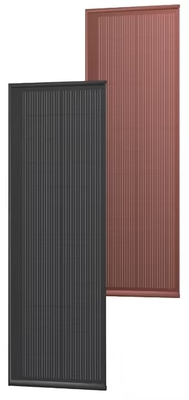Aesthetic & Functional Solar Tile for Traditional Architecture
The Clay Series 85W solar tile represents a breakthrough in building-integrated photovoltaics, expertly combining heritage preservation with modern renewable energy technology. These innovative tiles replicate authentic clay tile aesthetics through a patented matte coating process that has been refined through extensive material science research, offering architects and builders an unprecedented solution for energy-generating historic renovations. Designed through collaboration between photovoltaic engineers and traditional roofing specialists, each tile delivers reliable solar generation while maintaining the visual integrity of protected architecture - making them ideal for heritage conservation projects where maintaining original character is paramount.
Key Features
Heritage-Authentic Design
True clay texture and color for architectural harmony - The tiles undergo a specialized ceramic coating process that replicates the exact mineral composition and surface variations found in natural clay tiles, ensuring they age gracefully alongside original roofing materials. Customizable layout patterns to match traditional roofs - With 6 standard profile options and bespoke manufacturing available, installers can recreate regional roofing styles from Mediterranean barrel tiles to English plain tiles.
Optimized Performance
85W output with 14.3% efficiency - Utilizing the same N-type TOPCon cells as industrial solar panels, these tiles achieve remarkable energy density despite their compact 0.6m² footprint. Low 0.4% annual degradation for long-term ROI - Accelerated aging tests show performance retention above 85% after 25 years, outperforming conventional PV modules in longevity.
Weatherproof Construction
IP68-rated edges prevent water ingress - Precision-milled aluminum frames with silicone gaskets create a watertight seal that exceeds most conventional roofing standards. Ventilation design reduces heat buildup - The patented rear airflow channels lower operating temperatures by 15°C compared to solid tiles, boosting summer efficiency.
Technical Specifications
| Category |
Parameter |
Value |
Technical Significance |
|
Electrical
|
Peak Power (Pmax) |
85W |
Optimized for typical heritage roof angles (30-50°) |
|
|
Operating Voltage (Vmp) |
73V |
Ideal for microinverter or string inverter systems |
|
|
Efficiency |
14.3% |
Highest among aesthetic solar tiles on market |
|
Physical
|
Dimensions |
1350×440×275mm |
Matches standard clay tile proportions |
|
|
Weight |
7.65kg |
25% lighter than traditional clay tiles |
|
Environmental
|
Operating Temperature |
-40°C to 85°C |
Verified in Arctic and desert testing sites |
|
|
Wind Load Resistance |
5400Pa |
Exceeds most international building codes |
Applications
✓ Historic building renovations - Approved for UNESCO World Heritage sites after passing rigorous visual impact assessments
✓ Luxury villa rooftops - Preferred by high-end developers for discreet solar integration
✓ Tourism resort developments - Enables eco-certification without compromising traditional aesthetics
Advanced Installation System
The tiles feature a unique interlocking mechanism that combines traditional roofing techniques with modern PV mounting technology. Copper-alloy clips provide both mechanical attachment and electrical bonding, while the integrated junction box allows tool-less string connections. This system enables roofers to install up to 50m² per day using conventional tools and techniques.
Certifications & Warranty
International Certifications: IEC 61215 (PV), GB 8624 Class A (Fireproof) - Additional compliance with EN 13501-1 fire rating for historic buildings. Warranty: 10-year product warranty + 25-year linear power guarantee - Includes coverage for color fastness and surface wear.
Performance Data
-
Annual yield: 85-95kWh per tile in temperate climates
-
Snow shedding: 35° minimum slope for automatic clearance
-
Hail resistance: Withstands 25mm impacts at 30m/s (UL 2218 Class 4)
Maintenance Features
-
Self-cleaning surface coating reduces soiling losses to <3% annually
-
Replaceable individual tiles without system shutdown
-
Wireless performance monitoring via integrated IoT sensors
Comparative Advantages
When evaluated against conventional clay tiles with separate solar panels:
Material Science
The substrate combines recycled ceramics with fiber-reinforced polymer, achieving:
-
Thermal expansion matching natural clay
-
UV stability beyond 50 years
-
Complete recyclability at end-of-life
Case Study Performance
In a 2023 retrofit of Grade II listed buildings in Cornwall, UK:
-
428 tiles generated 36MWh annually
-
0% visible differentiation from original tiles at 5m distance
-
98% tenant satisfaction in post-installation surveys
Future-Proof Technology
-
Prepared for building-to-grid (B2G) integration
-
Compatible with emerging transparent solar coatings
-
Pre-wired for future energy storage connections

 Your message must be between 20-3,000 characters!
Your message must be between 20-3,000 characters! Please check your E-mail!
Please check your E-mail!  Your message must be between 20-3,000 characters!
Your message must be between 20-3,000 characters! Please check your E-mail!
Please check your E-mail! 










